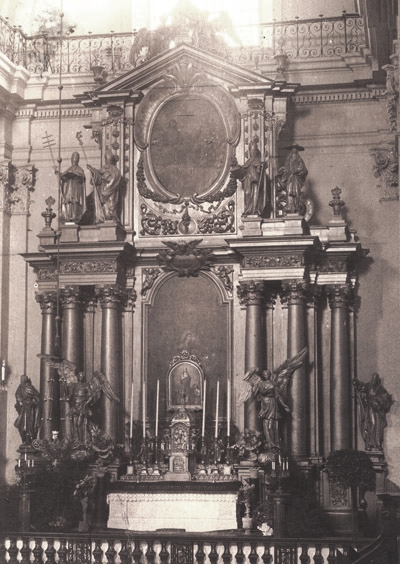|
Nicolas Chopin
Nicolas Chopin (in pl, Mikołaj Chopin; 15 April 17713 May 1844) was a teacher of the French language in Partitioned Poland, and father of Polish composer Frédéric Chopin.Łopaciński, "Chopin, Mikołaj," p. 426. Life Nicolas Chopin was born in the village of Marainville-sur-Madon (Vosges department), in the province of Lorraine, France. He was the son of François Chopin (9 November 1738, Ambacourt – 31 January 1814, Marainville), a wheelwright and village administrator for Marainville, and Marguerite, ''née'' Deflin (1 February 1736, Diarville – 21 August 1794, Marainville), an educator respected by her colleagues and students. François and Marguerite were married on 17 January 1769.Wróblewska-Straus, Hanna. "Nicolas Chopin". ''Korespondencja Fryderyka Chopina'', Vol. I, p. 571. Nicolas had four sisters, only two of whom survived to adulthood: Anne (b. 23 November 1769, Marainville), who married Joseph Thomas on 13 February 1798, and Marguerite (5 August 1775, ... [...More Info...] [...Related Items...] OR: [Wikipedia] [Google] [Baidu] |
Ambroży Mieroszewski
Ambroży Mieroszewski (1802–1884) was a Polish painter who was Frédéric Chopin's first known portraitist. Life Mieroszewski was active in Warsaw, in the Kingdom of Poland, at least as early as 1829. Works Mieroszewski's works included oil portraits, painted in 1829, of composer Frédéric Chopin (the earliest known portrait of him); his parents — Nicolas Chopin (1771–1844) and Justyna Chopin, ''née'' Krzyżanowska (1782–1861); the older sister of Fryderyk (as he then was) Ludwika (1807–1855), and his younger sister Izabela (1811–1881). In that same year, Mieroszewski also painted a portrait of the Fryderyk's first professional piano teacher, Wojciech Żywny.1884_deaths.html" ;"title="1802 births 1884 deaths">1802 births 1884 deaths 19th-century Polish painters 19th-century Polish male artists Polish portrait painters Polish male painters ... [...More Info...] [...Related Items...] OR: [Wikipedia] [Google] [Baidu] |
Pac Family
The House of Pac or Pacowie ( pl, Pacowie, lt, Pacai, be, Па́цы) was one of the most influential noble families in the Grand Duchy of Lithuania during the era of the Polish–Lithuanian Commonwealth. Numerous high-ranking officials of the Commonwealth came from their ranks. Their coat of arms was Gozdawa. The family reached the height of its influence during the second half of the 17th century. Their lands were located mainly in Hrodna ( pl, Grodno, lt, Gardinas) and Lida ( lt, Lyda). The family's ancestor Kimantas was mentioned in the privilege of 1388 issued by Grand Duke of Lithuania Vytautas the Great as ''Kymunt''. The estate of the family in proximity of Grodno was mentioned in the road description, charted by the Teutonic Knights, as ''Kymundsdorf''. Kimantas and his son Daukša (Dowkszewicz) were among the signatories of the Union of Vilnius and Radom of 1401. Daukša's son Pac is considered the first member of the family; his descendants took his first name ... [...More Info...] [...Related Items...] OR: [Wikipedia] [Google] [Baidu] |
Czerniewo, Masovian Voivodeship
Czerniewo is a village in the administrative district of Gmina Radzanowo, within Płock County, Masovian Voivodeship, in east-central Poland. It lies approximately north-east of Radzanowo, east of Płock, and north-west of Warsaw Warsaw ( pl, Warszawa, ), officially the Capital City of Warsaw,, abbreviation: ''m.st. Warszawa'' is the capital and largest city of Poland. The metropolis stands on the River Vistula in east-central Poland, and its population is officia .... References Czerniewo {{Płock-geo-stub ... [...More Info...] [...Related Items...] OR: [Wikipedia] [Google] [Baidu] |
Kościuszko Uprising
The Kościuszko Uprising, also known as the Polish Uprising of 1794 and the Second Polish War, was an uprising against the Russian Empire and the Kingdom of Prussia led by Tadeusz Kościuszko in the Polish–Lithuanian Commonwealth and the Prussian partition in 1794. It was a failed attempt to liberate the Polish–Lithuanian Commonwealth from external influence after the Second Partition of Poland (1793) and the creation of the Targowica Confederation. Background Decline of the Commonwealth By the early 18th century, the magnates of Poland and Lithuania controlled the state – or rather, they managed to ensure that no reforms would be carried out that might weaken their privileged status (the "Golden Freedoms"). Through the abuse of the '' liberum veto'' rule which enabled any deputy to paralyze the Sejm (Commonwealth's parliament) proceedings, deputies bribed by magnates or foreign powers or those simply content to believe they were living in an unprecedented "Go ... [...More Info...] [...Related Items...] OR: [Wikipedia] [Google] [Baidu] |
Partitions Of Poland
The Partitions of Poland were three partitions of the Polish–Lithuanian Commonwealth that took place toward the end of the 18th century and ended the existence of the state, resulting in the elimination of sovereign Poland and Lithuania for 123 years. The partitions were conducted by the Habsburg monarchy, the Kingdom of Prussia, and the Russian Empire, which divided up the Commonwealth lands among themselves progressively in the process of territorial seizures and annexations. The First Partition was decided on August 5, 1772 after the Bar Confederation lost the war with Russia. The Second Partition occurred in the aftermath of the Polish–Russian War of 1792 and the Targowica Confederation of 1792 when Russian and Prussian troops entered the Commonwealth and the partition treaty was signed during the Grodno Sejm on January 23, 1793 (without Austria). The Third Partition took place on October 24, 1795, in reaction to the unsuccessful Polish Kościuszko Uprising the previ ... [...More Info...] [...Related Items...] OR: [Wikipedia] [Google] [Baidu] |
Fryderyk Chopin
The Fryderyk is the annual award in Polish music. Its name refers to the original Polish spelling variant of Polish composer Frédéric Chopin's first name. Its status in the Polish public can be compared to the American Grammy and the UK's BRIT Award. Officially created in 1994 and presented for the first time in 1995, the award was initially conferred by the Polish Society of the Phonographic Industry (''Związek Producentów Audio-Video'', ZPAV). Since 1999, nominees and winners have been selected by a body called Phonographic Academy (''Akademia Fonograficzna'') which by now consists of nearly 1000 artists, journalists and music industry professionals. Voting is anonymous and takes place in two rounds: In the first round, all Academy members can nominate five artists in each category, in the second round, members can vote for one candidate in each category from the most successful nominees established in the first round. The Fryderyk statuette is reminiscent of the Academy ... [...More Info...] [...Related Items...] OR: [Wikipedia] [Google] [Baidu] |
French Revolution
The French Revolution ( ) was a period of radical political and societal change in France that began with the Estates General of 1789 and ended with the formation of the French Consulate in November 1799. Many of its ideas are considered fundamental principles of liberal democracy, while phrases like ''liberté, égalité, fraternité'' reappeared in other revolts, such as the 1917 Russian Revolution, and inspired campaigns for the abolition of slavery and universal suffrage. The values and institutions it created dominate French politics to this day. Its causes are generally agreed to be a combination of social, political and economic factors, which the ''Ancien Régime'' proved unable to manage. In May 1789, widespread social distress led to the convocation of the Estates General, which was converted into a National Assembly in June. Continuing unrest culminated in the Storming of the Bastille on 14 July, which led to a series of radical measures by the Assembly, i ... [...More Info...] [...Related Items...] OR: [Wikipedia] [Google] [Baidu] |
Army Of The Duchy Of Warsaw
Army of the Duchy of Warsaw (Polish: ''Armia Księstwa Warszawskiego'') refers to the military forces of the Duchy of Warsaw. The Army was significantly based on the Polish Legions; it numbered about 30,000 and was expanded during wartime to almost 100,000. It was composed of infantry with a strong cavalry force supported by artillery. The Napoleonic customs and traditions resulted in some social tensions, but are generally credited with helpful modernization and useful reforms. Size The cadre of the Army of the Duchy of Warsaw was formed by the legionnaires of the Polish Legions. In addition, it was filled by older soldiers from the Army of the Polish–Lithuanian Commonwealth, who responded to the call to arms of Józef Poniatowski, and patriotic youth. In 1808, after the first emergency period was over, and the Duchy felt more secure, those who wished to leave the army were given leave. The army was expanded with large waves of new recruits on the eve of new wars in 1809 and ... [...More Info...] [...Related Items...] OR: [Wikipedia] [Google] [Baidu] |
Krakowskie Przedmieście
Krakowskie Przedmieście (, literally: ''Cracow Fore-town''; french: link=no, Faubourg de Cracovie), often abbreviated to Krakowskie, is one of the best known and most prestigious streets of Poland's capital Warsaw, surrounded by historic palaces, churches and manor-houses. Krakowskie Przedmieście Royal Avenue constitutes the northernmost part of Warsaw's Royal Route, and links the Old Town and Royal Castle (at Castle Square) with some of the most notable institutions in Warsaw, including – proceeding southward – the Presidential Palace, Warsaw University, and the Polish Academy of Sciences headquartered in the Staszic Palace. The immediate southward extension of Krakowskie Przedmieście along the Royal Route is '' ulica Nowy Świat'' (''New World'' Street). Several other Polish cities also have streets named ''Krakowskie Przedmieście''. In Lublin, it is the main and most elegant street. Other cities include Piotrków Trybunalski, Bochnia, Krasnystaw, Olkusz, Sieradz an ... [...More Info...] [...Related Items...] OR: [Wikipedia] [Google] [Baidu] |
Holy Cross Church, Warsaw
The Church of the Holy Cross ( pl, Bazylika Świętego Krzyża) is a Roman Catholic house of worship in Warsaw, Poland. Located on ''Krakowskie Przedmieście'' opposite the main Warsaw University campus, it is one of the most notable Baroque churches in Poland's capital. The Holy Cross Church is currently administered by the Missionary Friars of Vincent de Paul. History As early as the 15th century, a small wooden chapel of the Holy Cross had been erected here. In 1526 the chapel was demolished, and a newer church was erected. Refurbished and extended by Paweł Zembrzuski in 1615, the church was too small to fill the needs of the growing city. Initially located well outside the city limits, by the 17th century it had become one of the main churches in the southern suburb (''przedmieście'') of the city that had in 1596 become Poland's capital. In 1653 Queen Marie Louise Gonzaga gave the church to the French order of Missionary Friars of Vincent de Paul. However, three years ... [...More Info...] [...Related Items...] OR: [Wikipedia] [Google] [Baidu] |
Tenements
A tenement is a type of building shared by multiple dwellings, typically with flats or apartments on each floor and with shared entrance stairway access. They are common on the British Isles, particularly in Scotland. In the medieval Old Town, in Edinburgh, tenements were developed with each apartment treated as a separate house, built on top of each other (such as Gladstone's Land). Over hundreds of years, custom grew to become law concerning maintenance and repairs, as first formally discussed in Stair's 1681 writings on Scots property law. In Scotland, these are now governed by the Tenements Act, which replaced the old Law of the Tenement and created a new system of common ownership and procedures concerning repairs and maintenance of tenements. Tenements with one or two room flats provided popular rented accommodation for workers, but in some inner-city areas, overcrowding and maintenance problems led to shanty towns, which have been cleared and redeveloped. In more affluen ... [...More Info...] [...Related Items...] OR: [Wikipedia] [Google] [Baidu] |








